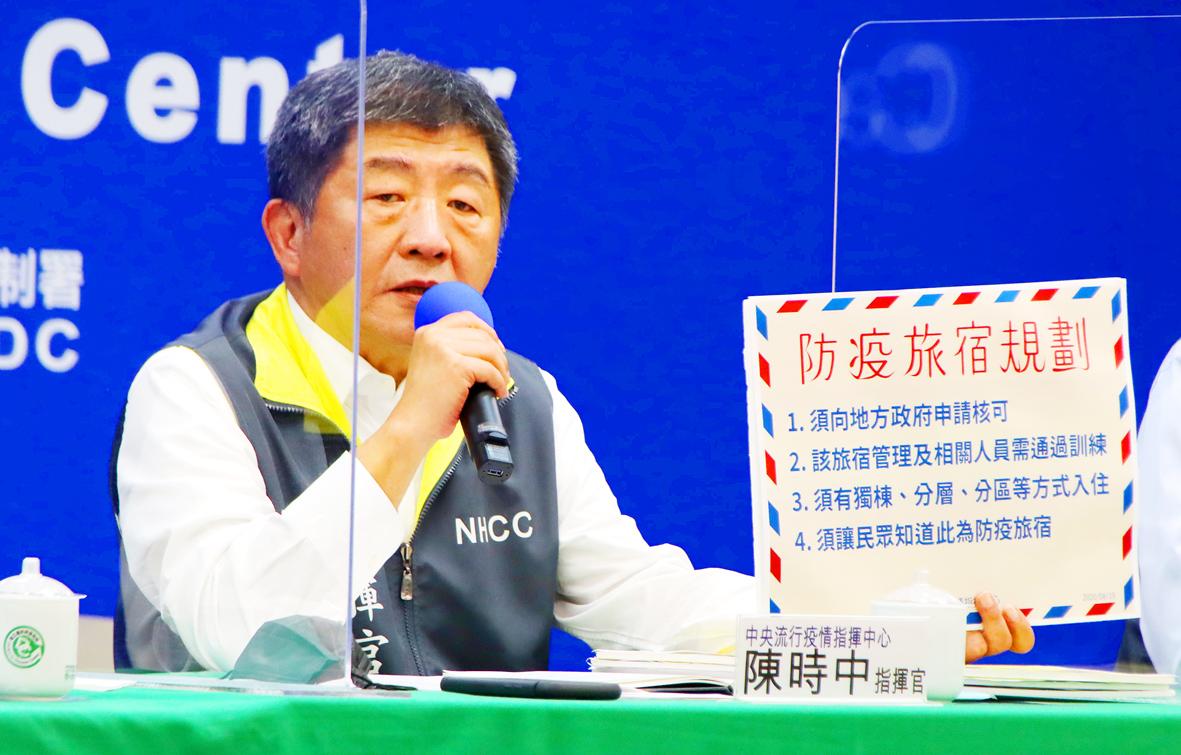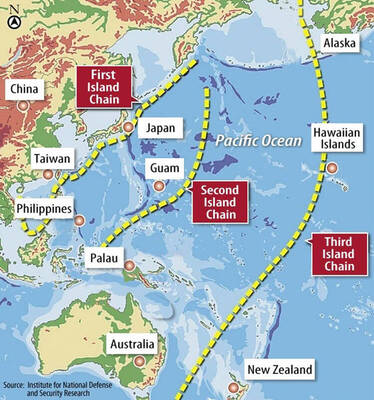Mass testing for COVID-19 on all travelers arriving in Taiwan could overwhelm the nation’s healthcare system, the Central Epidemic Command Center (CECC) said yesterday as it reported a new confirmed case, a Taiwanese who had returned from Mexico.
Minister of Health and Welfare Chen Shih-chung (陳時中), who heads the center, said that in the past few days the public has been widely debating the Changhua County Public Health Bureau’s testing policy, so he used a simulated scenario to explain why mass testing is not the best policy at this moment.
The bureau was found to have asked many people who had returned from other countries and were still under 14-day home quarantine to be tested for COVID-19, despite having no symptoms, which does not align with the CECC’s policy of only arranging for people in quarantine to be tested if they show symptoms.

Photo provided by the Central Epidemic Command Center via CNA
The bureau’s actions were revealed when the CECC on Monday reported that a Taiwanese teenager living in the US had tested positive on his 10th day of quarantine after returning for a family visit, even though he had no symptoms.
The case sparked controversy as Chen on Monday ordered the Department of Civil Service Ethics to launch an investigation to clarify the situation.
“People have been asking: ‘What is wrong with doing a little more [testing]?” in the past couple of days,” Chen said yesterday. “There is nothing wrong doing a little more if it is proper disease prevention, but if there are flaws in the process, it could result in a big problem.”
Since January about 250,000 people have been put under home isolation or quarantine after arriving in Taiwan, Chen said.
Using 0.2 percent as the prevalence rate — the median of COVID-19 prevalence rates in other countries — and a test kit with 90 percent sensitivity and 95 percent specificity to simulate mass testing on all the arriving travelers, there would be about 500 infected people, but only 450 of them would be detected, he said.
“Mass testing would result in 50 false-negative cases — infected people who tested as negative,” Chen said. “If people who tested negative are allowed to return home without quarantine, then the 50 false-negative cases being allowed to freely move around would most likely cause community spread.”
“Therefore, we know even if mass testing is conducted, mandatory quarantine is still necessary,” he said.
However, if a policy of mass testing following a 14-day quarantine is implemented, there would be about 12,475 false-positive cases — people who were not infected but tested positive, Chen said.
He said that the 12,475 false-positive cases would be hospitalized for about five to six days and would only be released from isolation after they tested negative twice consecutively, which would overwhelm healthcare capacity that should be preserved for people who actually need medical treatment.
The 12,475 people who were not infected would be placed in hospitals, which are high-risk environments, he said.
Contact tracing would need to be conducted on all 12,475 false-positive cases, which might result in all airline crew members being placed under home isolation, he added.
“From the disease situations in other countries, we known that once the healthcare system is overwhelmed, community spread will begin, because infected people cannot be hospitalized and have to go back into local communities,” Chen said.
He added that he is worried about the argument that “doing more testing would allow those who tested negative and their family members to feel safe,” because it does not mean that a person is immune to COVID-19, and sometimes a test result is negative because the person’s viral load was low at the time of testing.
“If people who test negative let their guard down, the risk of infection will increase,” Chen said, adding that it would cost about NT$800 million (US$27.1 million) if all 250,000 arriving travelers were tested, but the risk of local infection would increase.
Meanwhile, the new imported case reported yesterday is a woman in her 20s, who traveled to Mexico for work in late January and returned to Taiwan on Wednesday, the CECC said.
Ten passengers who sat near her during the flight back to Taiwan have been placed under home isolation, it said.
Fifteen crew members, who wore protective gear during the flight, would practice self-health management, it added.

The US government has signed defense cooperation agreements with Japan and the Philippines to boost the deterrence capabilities of countries in the first island chain, a report by the National Security Bureau (NSB) showed. The main countries on the first island chain include the two nations and Taiwan. The bureau is to present the report at a meeting of the legislature’s Foreign Affairs and National Defense Committee tomorrow. The US military has deployed Typhon missile systems to Japan’s Yamaguchi Prefecture and Zambales province in the Philippines during their joint military exercises. It has also installed NMESIS anti-ship systems in Japan’s Okinawa

‘WIN-WIN’: The Philippines, and central and eastern European countries are important potential drone cooperation partners, Minister of Foreign Affairs Lin Chia-lung said Minister of Foreign Affairs Lin Chia-lung (林佳龍) in an interview published yesterday confirmed that there are joint ventures between Taiwan and Poland in the drone industry. Lin made the remark in an exclusive interview with the Chinese-language Liberty Times (the Taipei Times’ sister paper). The government-backed Taiwan Excellence Drone International Business Opportunities Alliance and the Polish Chamber of Unmanned Systems on Wednesday last week signed a memorandum of understanding in Poland to develop a “non-China” supply chain for drones and work together on key technologies. Asked if Taiwan prioritized Poland among central and eastern European countries in drone collaboration, Lin

ON ALERT: Taiwan’s partners would issue warnings if China attempted to use Interpol to target Taiwanese, and the global body has mechanisms to prevent it, an official said China has stationed two to four people specializing in Taiwan affairs at its embassies in several democratic countries to monitor and harass Taiwanese, actions that the host nations would not tolerate, National Security Bureau (NSB) Director-General Tsai Ming-yen (蔡明彥) said yesterday. Tsai made the comments at a meeting of the legislature’s Foreign Affairs and National Defense Committee, which asked him and Minister of National Defense Wellington Koo (顧立雄) to report on potential conflicts in the Taiwan Strait and military preparedness. Democratic Progressive Party (DPP) Legislator Michelle Lin (林楚茵) expressed concern that Beijing has posted personnel from China’s Taiwan Affairs Office to its

BACK TO WORK? Prosecutors said they are considering filing an appeal, while the Hsinchu City Government said it has applied for Ann Kao’s reinstatement as mayor The High Court yesterday found suspended Hsinchu mayor Ann Kao (高虹安) not guilty of embezzling assistant fees, reducing her sentence to six months in prison commutable to a fine from seven years and four months. The verdict acquitted Kao of the corruption charge, but found her guilty of causing a public official to commit document forgery. The High Prosecutors’ Office said it is reviewing the ruling and considering whether to file an appeal. The Taipei District Court in July last year sentenced Kao to seven years and four months in prison, along with a four-year deprivation of civil rights, for contravening the Anti-Corruption